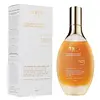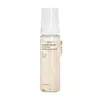What's inside
What's inside
 Key Ingredients
Key Ingredients

 Benefits
Benefits

 Concerns
Concerns

 Ingredients Side-by-side
Ingredients Side-by-side

Lactobacillus Ferment
Skin ConditioningWater
Skin ConditioningGlycerin
HumectantDisodium Cocoyl Glutamate
CleansingPEG-6 Caprylic/Capric Glycerides
EmulsifyingCocamidopropyl Betaine
CleansingPotassium Cocoyl Glycinate
Tea-Cocoyl Glutamate
CleansingAcrylates Copolymer
Lauric Acid
CleansingPropylene Glycol
HumectantPhenoxyethanol
Preservative1,2-Hexanediol
Skin ConditioningIsoceteth-20
EmulsifyingCitrus Aurantium Bergamia Fruit Oil
MaskingChlorphenesin
AntimicrobialDisodium EDTA
Caramel
Cosmetic ColorantSodium PCA
HumectantPelargonium Graveolens Flower Oil
MaskingO-Cymen-5-Ol
AntimicrobialGluconolactone
Skin ConditioningSalvia Sclarea Oil
MaskingButylene Glycol
HumectantBifida Ferment Lysate
Skin ConditioningImperata Cylindrica Root Extract
Skin ConditioningPeumus Boldus Leaf Extract
MaskingPentylene Glycol
Skin ConditioningLens Esculenta Seed Extract
Skin ProtectingPEG-8
HumectantCamellia Sinensis Leaf Extract
AntimicrobialAlteromonas Ferment Extract
Skin ConditioningSalix Alba Bark Extract
AstringentTocopherol
AntioxidantCarbomer
Emulsion StabilisingXanthan Gum
EmulsifyingPotassium Sorbate
PreservativeEthylhexylglycerin
Skin ConditioningSodium Benzoate
MaskingSorbic Acid
PreservativeLactobacillus Ferment, Water, Glycerin, Disodium Cocoyl Glutamate, PEG-6 Caprylic/Capric Glycerides, Cocamidopropyl Betaine, Potassium Cocoyl Glycinate, Tea-Cocoyl Glutamate, Acrylates Copolymer, Lauric Acid, Propylene Glycol, Phenoxyethanol, 1,2-Hexanediol, Isoceteth-20, Citrus Aurantium Bergamia Fruit Oil, Chlorphenesin, Disodium EDTA, Caramel, Sodium PCA, Pelargonium Graveolens Flower Oil, O-Cymen-5-Ol, Gluconolactone, Salvia Sclarea Oil, Butylene Glycol, Bifida Ferment Lysate, Imperata Cylindrica Root Extract, Peumus Boldus Leaf Extract, Pentylene Glycol, Lens Esculenta Seed Extract, PEG-8, Camellia Sinensis Leaf Extract, Alteromonas Ferment Extract, Salix Alba Bark Extract, Tocopherol, Carbomer, Xanthan Gum, Potassium Sorbate, Ethylhexylglycerin, Sodium Benzoate, Sorbic Acid
Brassica Oleracea Italica Extract
AstringentWater
Skin ConditioningCentella Asiatica Extract
CleansingPortulaca Oleracea Extract
Skin ConditioningGlycerin
HumectantDisodium Cocoamphodiacetate
CleansingDecyl Glucoside
CleansingButylene Glycol
HumectantSodium Chloride
Masking1,2-Hexanediol
Skin ConditioningSodium Dna
Skin ConditioningSalmon Egg Extract
Madecassoside
AntioxidantPersea Gratissima Fruit Extract
EmollientMaltodextrin
AbsorbentEthylhexylglycerin
Skin ConditioningDisodium EDTA
Potassium Benzoate
PreservativeHexylene Glycol
EmulsifyingCitric Acid
BufferingBrassica Oleracea Italica Extract, Water, Centella Asiatica Extract, Portulaca Oleracea Extract, Glycerin, Disodium Cocoamphodiacetate, Decyl Glucoside, Butylene Glycol, Sodium Chloride, 1,2-Hexanediol, Sodium Dna, Salmon Egg Extract, Madecassoside, Persea Gratissima Fruit Extract, Maltodextrin, Ethylhexylglycerin, Disodium EDTA, Potassium Benzoate, Hexylene Glycol, Citric Acid
Ingredients Explained
These ingredients are found in both products.
Ingredients higher up in an ingredient list are typically present in a larger amount.
1,2-Hexanediol is a synthetic liquid and another multi-functional powerhouse.
It is a:
- Humectant, drawing moisture into the skin
- Emollient, helping to soften skin
- Solvent, dispersing and stabilizing formulas
- Preservative booster, enhancing the antimicrobial activity of other preservatives
Butylene Glycol (or BG) is used within cosmetic products for a few different reasons:
Overall, Butylene Glycol is a safe and well-rounded ingredient that works well with other ingredients.
Though this ingredient works well with most skin types, some people with sensitive skin may experience a reaction such as allergic rashes, closed comedones, or itchiness.
Learn more about Butylene GlycolDisodium EDTA plays a role in making products more stable by aiding other preservatives.
It is a chelating agent, meaning it neutralizes metal ions that may be found in a product.
Disodium EDTA is a salt of edetic acid and is found to be safe in cosmetic ingredients.
Learn more about Disodium EDTAEthylhexylglycerin (we can't pronounce this either) is commonly used as a preservative and skin softener. It is derived from glyceryl.
You might see Ethylhexylglycerin often paired with other preservatives such as phenoxyethanol. Ethylhexylglycerin has been found to increase the effectiveness of these other preservatives.
Glycerin is already naturally found in your skin. It helps moisturize and protect your skin.
A study from 2016 found glycerin to be more effective as a humectant than AHAs and hyaluronic acid.
As a humectant, it helps the skin stay hydrated by pulling moisture to your skin. The low molecular weight of glycerin allows it to pull moisture into the deeper layers of your skin.
Hydrated skin improves your skin barrier; Your skin barrier helps protect against irritants and bacteria.
Glycerin has also been found to have antimicrobial and antiviral properties. Due to these properties, glycerin is often used in wound and burn treatments.
In cosmetics, glycerin is usually derived from plants such as soybean or palm. However, it can also be sourced from animals, such as tallow or animal fat.
This ingredient is organic, colorless, odorless, and non-toxic.
Glycerin is the name for this ingredient in American English. British English uses Glycerol/Glycerine.
Learn more about GlycerinWater. It's the most common cosmetic ingredient of all. You'll usually see it at the top of ingredient lists, meaning that it makes up the largest part of the product.
So why is it so popular? Water most often acts as a solvent - this means that it helps dissolve other ingredients into the formulation.
You'll also recognize water as that liquid we all need to stay alive. If you see this, drink a glass of water. Stay hydrated!
Learn more about Water